
Angliyskiy
.pdfGRAMMAR
Passive Voice
|
Present |
Past |
Future |
||
|
|
|
|
|
|
Indefinite |
am/are/is given |
was/were given |
shall/will be given |
||
|
|
|
|
|
|
Continuous |
am/are/is being |
was/were being |
- |
|
|
given |
given |
|
|||
|
|
|
|||
|
|
|
|
|
|
Perfect |
has/have been |
had been given |
shall/will have |
||
given |
been given |
||||
|
|
||||
|
|
|
|
|
|
Perfect |
- |
- |
- |
|
|
Continuous |
|
||||
|
|
|
|
||
|
|
|
|
|
|
|
|
|
|
||
|
Past Participle |
|
|
||
|
|
|
|||
Regular verbs |
Irregular verbs |
|
|||
|
|
|
|
||
|
+ -ed |
see table of irregular verbs |
|
||
|
|
|
|
||
work+ed = worked |
find - found |
|
|
||
like +ed= liked |
go –gone |
|
|
||
|
|
|
|
|
|
10. Write passive sentences in Simple Present, Simple Past.
1)the documents / print
2)the window / open
3)the shoes / buy
4)the car / wash
5)the litter / throw away
6)the letter / send
7)the book / read / not
8)the songs / sing / not
9)the food / eat / not
10)the shop / close / not
121
SELF-STUDY
11. Read the text and answer the questions.
The United Kingdom of Great Britain and Northern Ireland
Conventional short form: The United Kingdom
Abbreviation: The UK
The United Kingdom of Great Britain and Northern Ireland is situated on the British Isles. The British Isles consists of two large islands, Great Britain and Ireland, and about five thousand small islands. Their total area is over 244,000 square kilometres.
The UK is made up of four countries: England, Wales, Scotland and Northern Ireland. GB consists of England, Scotland and Wales and doesn't include Northern Ireland. The capital of the UK is London.
The British Isles are separated from European continent by the North Sea and the English Channel. The western coast of GB is washed by the Atlantic Ocean and the Irish Sea.
The surface of the British Isles varies very much. The north of Scotland is mountainous and is called the Highlands, while the south, which has beautiful valleys and plains, is called the Lowlands. The highest mountain Ben Nevis (1343) is in Scotland; the highest peak in Wales is Snowdon (1085).
There are a lot of rivers in GB, but they are not very long. The Severn is the longest river, while the Thames is the deepest and the most important one.
The mountains, the Atlantic Ocean and the warm waters of Gulf Stream influence the climate of the British Isles. The UK enjoys warmer winters and cooler summers than other countries at the same latitude.
122
The most unpleasant aspect of English weather is fog and smog. This is extremely bad in big cities especially in London. The fog spreads everywhere so cars move along slowly and people can't see each other. They try not to be run over by a car but still accidents are frequent in the fog.
The flora of the British Isles is varied and the fauna is similar to that of the north-west of Europe.
The country is not very rich in natural resources. Over three quarters of Britain‘s land is used for farming; farms produce nearly half of the food that Britain needs. The UK is a highly developed industrial country too, known as a producer and exporter of machinery, electronics, ships, aircraft and navigation equipment.
Vocabulary
The United Kingdom of Great Britain and Northern Ireland [ju:'natid 'kiŋdəm əv 'greit 'britn ənd 'nɔ:ðən 'aiələnd]
England ['iŋglənd]
Scotland ['skɒtlənd]
Wales ['weilz]
London ['lʌndən]
the Gulf Stream ['gʌlf 'stri:m]
to separate from - отделять от
to influence - влиять
latitude ['lætɪt(j)uːd] - широта
to produce - производить
aircraft and navigation equipment - оборудование для авиационной и судостроительной промышленности
12.Answer the questions.
1.Where is Great Britain situated?
2.What parts does the United Kingdom include?
123
3.What are the most important isles?
4.How can you define the climate of Great Britain?
5.What goods are produced in the UK?
13. Complete the sentences.
1.The United Kingdom of Great Britain and Northern Ireland is situated on the___.
2.The British Isles consists of two large islands: ___ and ___, and about ___ thousand small islands.
3.The UK is made up of four countries: ___, ___, ___ and ___.
4.The British Isles are separated from European continent by the
___ and the ___.
5.The north of Scotland is mountainous and is called the ___, the south is called the ___. The highest mountain is ___.
6.The longest river is ___.
7.The ___ is the deepest and the most important river.
8.The warm waters of ___ influence the climate of the British Isles.
9.The country is not very rich in natural ___.
10.Over three quarters of Britain‘s land is used for ___.
11.The UK is a highly ___ industrial country.
The Flag of the United Kingdom
14. Read the text and complete it with verbs from the box.
symbolises |
is called |
was |
is made |
is |
|
|
|
|
|
124

The Union Flag, known as the Union Jack, [1] ___ the national flag of the United Kingdom. It [2] ___ the Union Flag because it [3] ___ the administrative union of the
countries of the United Kingdom. It [4] ___ up of the individual Flags of three of the Kingdom's countries all united under one Sovereign - the countries of England, of Scotland and of Northern Ireland (since 1921 only Northern Ireland has been part of the United Kingdom). As Wales [5] ___ not a Kingdom but a Principality it could not be included on the flag.
The Making of the Union Flag
|
|
|
England is |
Scotland is |
Ireland is |
represented by the |
represented by the |
represented by the |
flag of |
flag of |
cross of |
St. George |
St. Andrew |
St. Patrick |
|
|
|
15. Read the text and focus attention on the sights of London.
London
I
London is the capital city of England and the United Kingdom situated on the Thames river, the largest city in Britain and one of the largest cities in the world.
From the earliest times the Romans, the Saxons, the Danes and the Normans settled there in turn. With the passing years London continued to grow in importance and prosperity. The
125
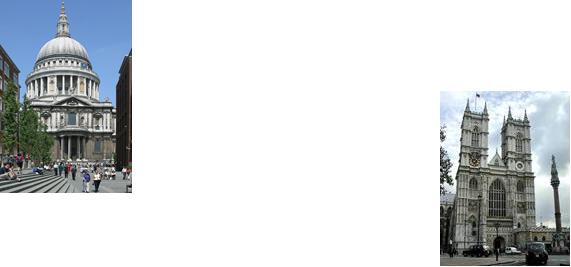
existence of London depended on its water-born trade which still makes London one of the world‘s largest ports. Historical and geographical circumstances have turned London into one of the world‘s most important commercial and cultural centres. The first mayor of London was elected in 1193, but for more than a thousand years before that London had been a place of some importance.
London survived the Plague, which killed nearly 70.000 people, and the Great Fire which followed. Little damage occurred during World War I, but World War II brought tremendous destruction to the city: a great number of buildings of historic value were laid in
ruins. Yet much was spared, including the Tower, St. Paul‘s
Cathedral and Westminster Abbey which remain the major
tourist attractions of the city.
London manages in a unique way to reflect the past and, at the same time, to live a life of a
modern city. There is always something new to be discovered, some fresh approach to a familiar scene, some curious piece of life in the city where the old and new exist side by side in mutual tolerance and respect.
Vocabulary
the Plague [pleig] - Великая чума (эпидемия бубонной чумы в Лондоне в 1664-1665 годах, унесшая 70 000жизней при населении Англии 460 000 человек)
the Great Fire - Великий пожар в Лондоне в 1666 году (уничтожил более половины города, в том числе старое здание собора Св. Павла)
prosperity - процветание
126
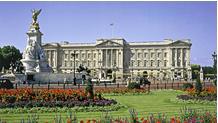
circumstances ['sə:kəmstəns] - обстоятельства
to survive - выживать
damage - повреждения
to occur [ə'kə:] - происходить, случаться
tremendous [tri'mendəs] destruction - значительные разрушения
to be laid in ruins [ruin] - разрушиться, превратиться в развалины
to be spared - сохраниться
major tourist attraction - основной предмет интереса туристов
unique [ju:'ni:k] - уникальный
an approach to - подход к
mutual ['mjuːʧuəl] tolerance and respect - взаимная терпимость и уважение
II
London consists of three parts: the City of London, the West End and the East End. These are not merely geographical names.
The City extends over an area of about 2.6 square kilometers in the heart of London. About half a million people work in the City but only less than 6000 live here. It is the financial centre of the UK with many banks, offices and Stock Exchange. But the City is also a market for goods of almost every kind, from all parts of the world.
The West End consists of the fashionable houses of the rich, art galleries, famous museums, theatres, palaces and parks. Here are the
historical palaces as well as the famous parks. Hyde Park with its Speaker's Corner is also here. Among other parks are Kensington Gardens, St. James's Park. In the West End is Buckingham Palace.
127
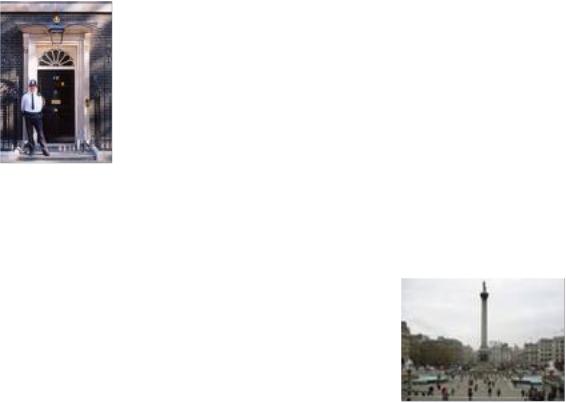
Which is the Queen's residence, and the Palace of Westminster which is the seat of Parliament.
The best-known streets here are Whitehall with important Government offices, Downing Street, the London residence of Prime Minister and the place where the Cabinet meets, Fleet Street where most newspapers have their offices, Harley Street where the highest paid doctors live, and some others.
Trafalgar Square is named so in commemoration of Nelson's great victory in the battle of Trafalgar in 1805. In the middle stands the famous Nelson Column with the statue of Nelson 170 feet high. The column stands in the geographical centre of the city. It is one of the best open air platforms
for public meetings and demonstrations.
One of the "musts" for the sightseer are the Houses of Parliament, facing the Thames, on one side, and Parliament Square and
Westminster Abbey, on the other. The House of Commons sits to the side of the Clock Tower (Big Ben), the House of Lords - to the Victoria Tower side.
Westminster Abbey is the crowning and burial place of British monarchs. It has its world famed Poet's Corner with memorials to Shakespeare, Burns, Dickens, Kipling and other leading writers. Only a few however, are actually buried there.
The name "West End" came to be associated with wealth, luxury, and goods of high quality. It is the area of the largest department stores, cinemas and hotels. There are about 40 theatres, several concert halls, many museums including the British Museum, and the best art galleries.
The Port of London is to the east of the City. Here today are kilometres and kilometres of docks, and the great industrial areas that depend upon shipping. The East End is still a poorer district full of factories and plants; it is a district were poorer people live
128
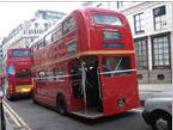
too, though it can no longer be called a district of the poor as housing conditions have improved. This is the East End of London, unattractive in appearance, but very important to the country's commerce.
London is always full of life. The streets are crowded with traffic. High ‗doubledecker‘ buses rise above the smaller cars and vans. The city of London today is the financial powerhouse of the country and one
of the chief commercial centers of the western world. The city has its own Lord Major, its own Government and its own police force. Here the medieval buildings stand side by side with modern glass high-rise offices.
Vocabulary
merely ['mɪəlɪ] − только
Stock Exchange ['stɔkiks¸ʧeinʤ] − Лондонская фондовая биржа
in commemoration of [kəmemə'reiʃ(ə)n] − в память о ком-л,
чем-л.
sightseer ['sait¸siə] − турист, осматривающий достопримечательности
bury − хоронить
‗double-decker‘ bus – двухэтажный автобус (в Лондоне красный)
16. Complete the text using the given words.
Thames |
The West End |
The City |
buses |
fog |
centuries |
|
|
|
|
|
|
world |
The East End |
capital |
rain |
population |
divided |
|
|
|
|
|
|
129
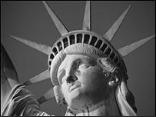
1)London is the ____ of Great Britain, its political, economic and commercial centre.
2)It is one of the largest cities in the ___.
3)Its ____ is about 8 million.
4)London is situated on the river ____.
5)The city is very old. It has more than 20 ____ old history.
6)Traditionally it is ____ into several parts: the City, the West End and the East End.
7)____ is the oldest part of London, its financial and business centre. Numerous banks, offices and firms are concentrated here.
8)____ is the richest and most beautiful part of London. The best hotels, restaurants, shops, clubs, parks and houses are situated there.
9)____ is an industrial district of London. The old port area is now called "Docklands". There are now new office buildings in Docklands, and thousands of new flats and houses.
10)London has rather wide streets but low houses. It looks very grey because there is so much _____ and ____ there. Only ____
are red.
The United States of America
17. Read the text and complete it with suitable verbs.
1.The United States of America consists / lies in the central part of the North American Continent between the two oceans: the Atlantic Ocean to the East and the Pacific Ocean to the West.
2.The USA is / consists of three separate parts. They are the Hawaiian Islands, situated in the central part of the Pacific Ocean, Alaska separated by the Canadian territory and the rest major part of the USA.
130
